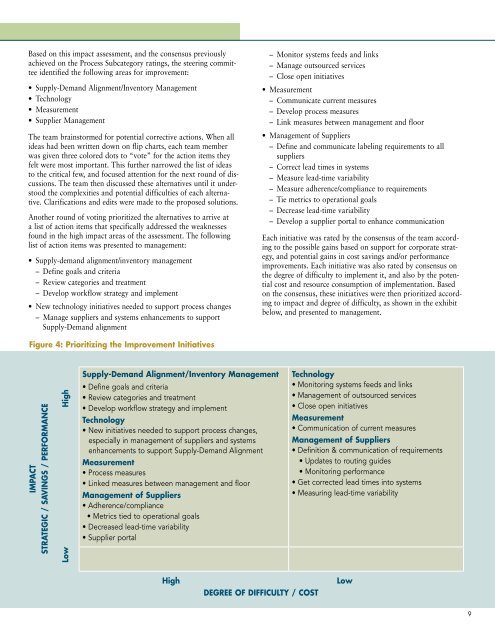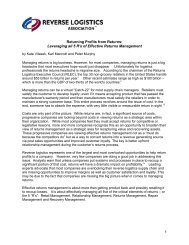PROCESS ASSESSMENT IN THE SUPPLY CHAIN: the eMBARQtM ...
PROCESS ASSESSMENT IN THE SUPPLY CHAIN: the eMBARQtM ...
PROCESS ASSESSMENT IN THE SUPPLY CHAIN: the eMBARQtM ...
You also want an ePaper? Increase the reach of your titles
YUMPU automatically turns print PDFs into web optimized ePapers that Google loves.
Based on this impact assessment, and <strong>the</strong> consensus previously<br />
achieved on <strong>the</strong> Process Subcategory ratings, <strong>the</strong> steering committee<br />
identified <strong>the</strong> following areas for improvement:<br />
• Supply-Demand Alignment/Inventory Management<br />
• Technology<br />
• Measurement<br />
• Supplier Management<br />
The team brainstormed for potential corrective actions. When all<br />
ideas had been written down on flip charts, each team member<br />
was given three colored dots to “vote” for <strong>the</strong> action items <strong>the</strong>y<br />
felt were most important. This fur<strong>the</strong>r narrowed <strong>the</strong> list of ideas<br />
to <strong>the</strong> critical few, and focused attention for <strong>the</strong> next round of discussions.<br />
The team <strong>the</strong>n discussed <strong>the</strong>se alternatives until it understood<br />
<strong>the</strong> complexities and potential difficulties of each alternative.<br />
Clarifications and edits were made to <strong>the</strong> proposed solutions.<br />
Ano<strong>the</strong>r round of voting prioritized <strong>the</strong> alternatives to arrive at<br />
a list of action items that specifically addressed <strong>the</strong> weaknesses<br />
found in <strong>the</strong> high impact areas of <strong>the</strong> assessment. The following<br />
list of action items was presented to management:<br />
• Supply-demand alignment/inventory management<br />
– Define goals and criteria<br />
– Review categories and treatment<br />
– Develop workflow strategy and implement<br />
• New technology initiatives needed to support process changes<br />
– Manage suppliers and systems enhancements to support<br />
Supply-Demand alignment<br />
Figure 4: Prioritizing <strong>the</strong> improvement initiatives<br />
iMPAct<br />
stRAtegic / sAvings / PeRFoRMAnce<br />
Low high<br />
supply-Demand Alignment/inventory Management<br />
• Define goals and criteria<br />
• Review categories and treatment<br />
• Develop workflow strategy and implement<br />
technology<br />
• New initiatives needed to support process changes,<br />
especially in management of suppliers and systems<br />
enhancements to support Supply-Demand Alignment<br />
Measurement<br />
• Process measures<br />
• Linked measures between management and floor<br />
Management of suppliers<br />
• Adherence/compliance<br />
• Metrics tied to operational goals<br />
• Decreased lead-time variability<br />
• Supplier portal<br />
– Monitor systems feeds and links<br />
– Manage outsourced services<br />
– Close open initiatives<br />
• Measurement<br />
– Communicate current measures<br />
– Develop process measures<br />
– Link measures between management and floor<br />
• Management of Suppliers<br />
– Define and communicate labeling requirements to all<br />
suppliers<br />
– Correct lead times in systems<br />
– Measure lead-time variability<br />
– Measure adherence/compliance to requirements<br />
– Tie metrics to operational goals<br />
– Decrease lead-time variability<br />
– Develop a supplier portal to enhance communication<br />
high Low<br />
DegRee oF DiFFicuLty / cost<br />
Each initiative was rated by <strong>the</strong> consensus of <strong>the</strong> team according<br />
to <strong>the</strong> possible gains based on support for corporate strategy,<br />
and potential gains in cost savings and/or performance<br />
improvements. Each initiative was also rated by consensus on<br />
<strong>the</strong> degree of difficulty to implement it, and also by <strong>the</strong> potential<br />
cost and resource consumption of implementation. Based<br />
on <strong>the</strong> consensus, <strong>the</strong>se initiatives were <strong>the</strong>n prioritized according<br />
to impact and degree of difficulty, as shown in <strong>the</strong> exhibit<br />
below, and presented to management.<br />
technology<br />
• Monitoring systems feeds and links<br />
• Management of outsourced services<br />
• Close open initiatives<br />
Measurement<br />
• Communication of current measures<br />
Management of suppliers<br />
• Definition & communication of requirements<br />
• Updates to routing guides<br />
• Monitoring performance<br />
• Get corrected lead times into systems<br />
• Measuring lead-time variability<br />
9




